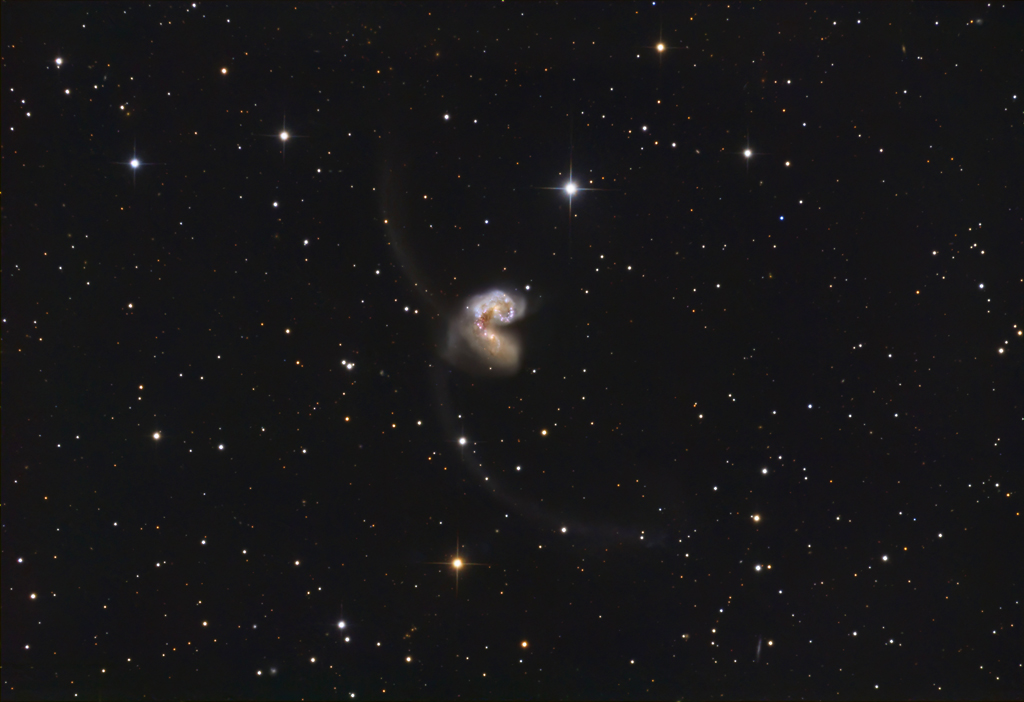 |
CHAMÄLEON + ONJALA OBSERVATORY DeepSky | SITEMAP HOME CHAMÄLEON |
|
 |
|||
| « zurück zur Startseite
Galaxien « back to home galaxies |
Großes Bild laden - load large image 2048 x 1400 Pixel Aufnahmedaten Image data |
NGC 4038 + NGC 4039 - the "antennae" or "rat tail" galaxies in the constellation Corvus

NGC 4038/39 - Arp 244 - Unser Bild zeigt in hoher Auflösung die so genannten Antennengalaxien NGC 4038 + NGC 4039 im Sternbild Rabe. Sie sind wohl das prominenteste Beispiel für verschmelzende, miteinander kollidierende und wechselwirkende (interacting) Galaxien. Wir sehen hier einen Prozess - der schon einige 100 Millionen Jahre andauert - indem aber nicht einzelne Sterne miteinander kollidieren, sondern riesige interstellare Gas- und Staubwolken, wobei heftige Sternentstehung ausgelöst wird. Parallel dazu haben sich durch Gezeitenkräfte die beiden lang gezogenen, bogenförmigen Filamente gebildet, die aus neu entstandenen Sternen bestehen.
Die Entfernung zum Sonnensystem liegt irgendwo zwischen 65- und 70 Millionen Lichtjahre und unser Bild überdeckt in der Breite etwa 500.000 Lichtjahre. Das Galaxienpaar wurde am 7. Februar 1785 von Friedrich Wilhelm Herschel entdeckt.
Die Katalognummer Arp 244 geht auf den US-amerikanischen Astronomen Halton Arp zurück, der im vorigen Jahrhundert einen Katalog, indem er solche wechselwirkende, kollidierenden Galaxien zusammen fasste und eine Klassifizierung einführte. Es ist der Katalog "ARP ATLAS OF PECULIAR GALAXIES", den Sie hier online finden. Eine Weitwinkelansicht von Arp 244 zeigen wir hier. Dort finden Sie auch viele weiterführende Information zu den Antennen Galaxien und zum Leben von Halton Arp.
Object description
NGC 4038/39 - Arp 244 - Our image shows in high resolution the so-called Antennae galaxies NGC 4038 + NGC 4039 in the constellation Raven. They are probably the most prominent example of merging, colliding and interacting galaxies. We see here a process - which already lasts some 100 million years - in which not single stars collide with each other, but huge interstellar gas and dust clouds, triggering violent star formation. In parallel, tidal forces have formed the two elongated, arcuate filaments consisting of newly formed stars.
The distance to the solar system is somewhere between 65 and 70 million light-years and our image covers about 500,000 light-years in width. The pair of galaxies was discovered by Friedrich Wilhelm Herschel on February 7, 1785.
The catalog number Arp 244 goes back to the US astronomer Halton Arp, who in the last century created a catalog by grouping such interacting, colliding galaxies and introduced a classification. It is the catalog "ARP ATLAS OF PECULIAR GALAXIES", which you can find online here. We show a wide field view of Arp 244 here. There you will also find a lot of further information about the Antennae Galaxies and the life of Halton Arp.
NGC 4038 + NGC 4039 - the "antennae" or "rat tail" galaxies in the constellation Corvus
Image data
Date: some nights in june 2022 - 33 x 600 s, QHY ALccd 12 (cooled)
Telescope: CDK 12.5" PlaneWave Astrograph + 0.8x Reducer at f = 2030 mmm
Location: Chamäleon Observatory, Onjala Lodge, Namibia
Image acquisition and processing: DeepSkyStacker, PixInsight + Photoshop by Bernd Gooßmann
 |
 |
 |
 |
 |
 |
 |
| Sonne | Mond | Sonnensystem | DeepSky | Weitwinkel | Verschiedenes | Spez. Projekte |